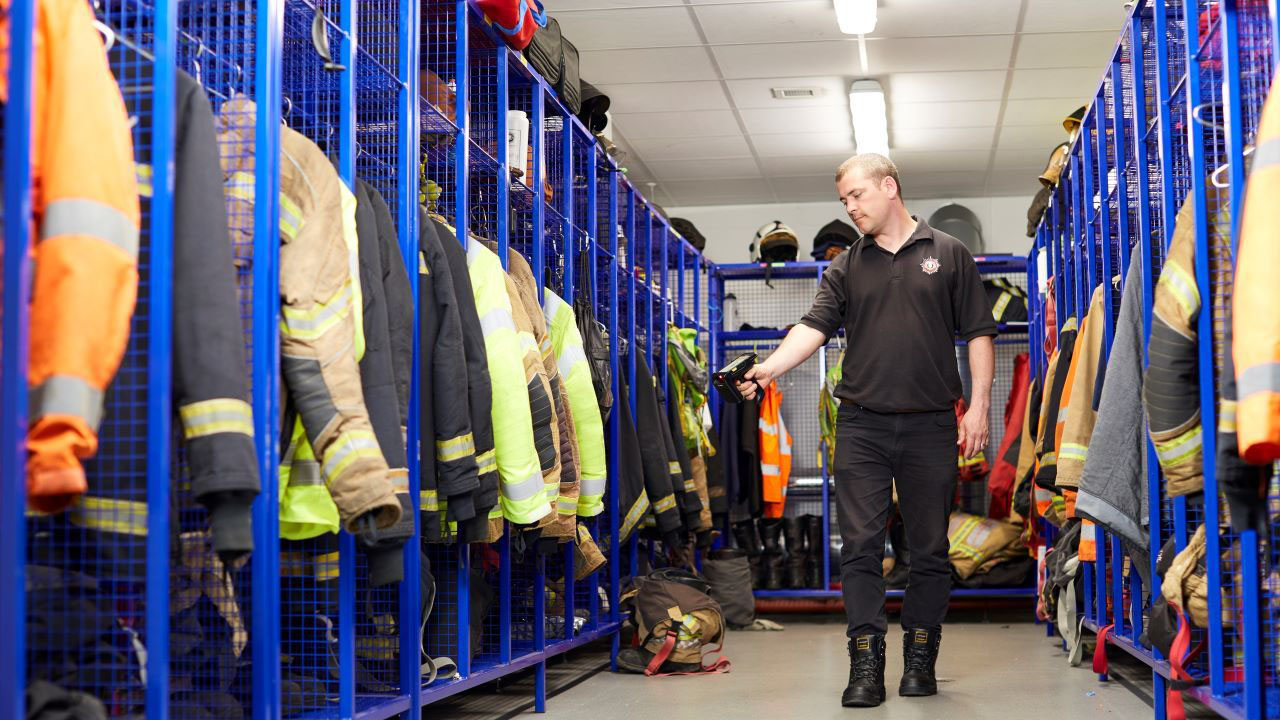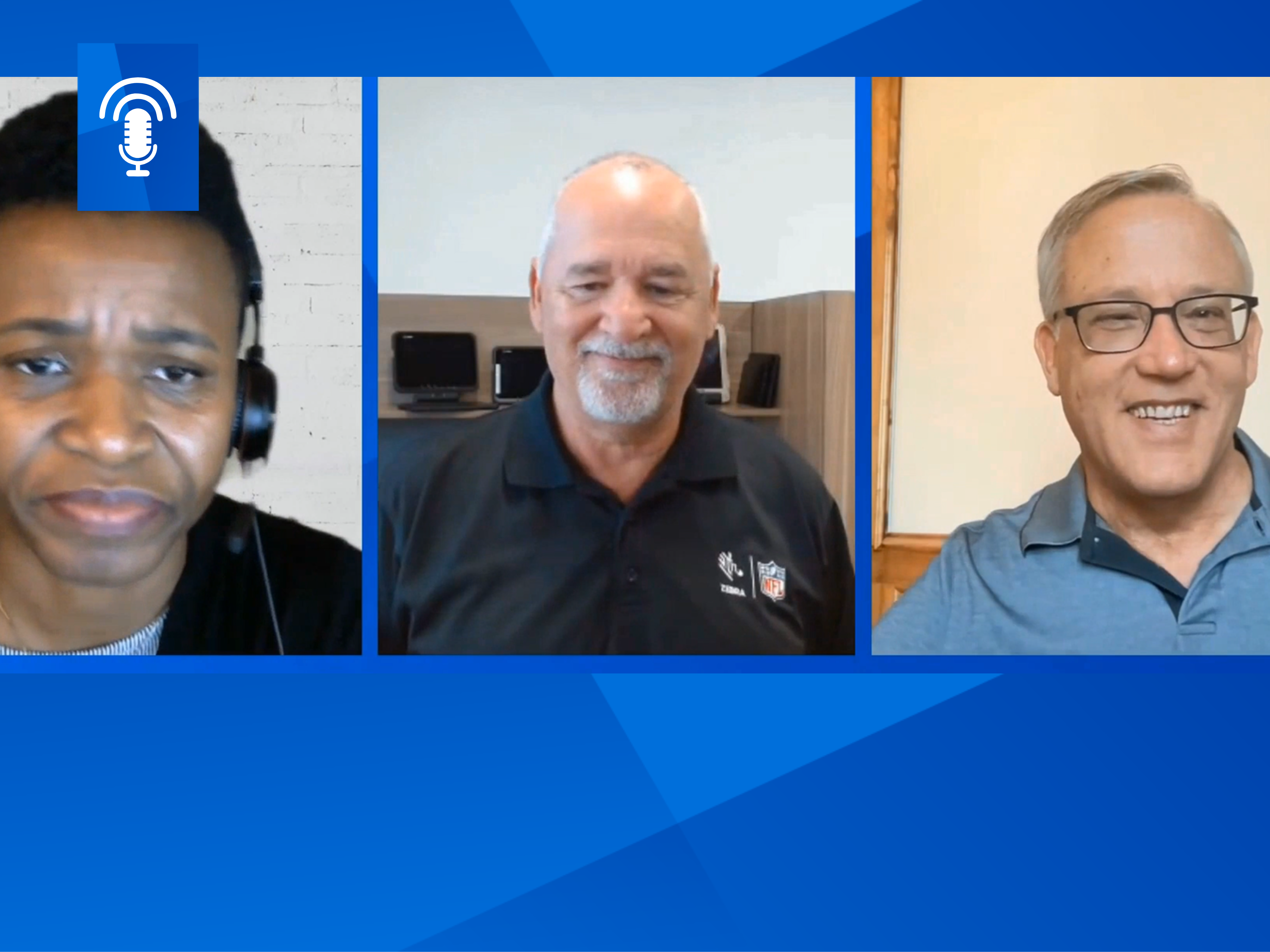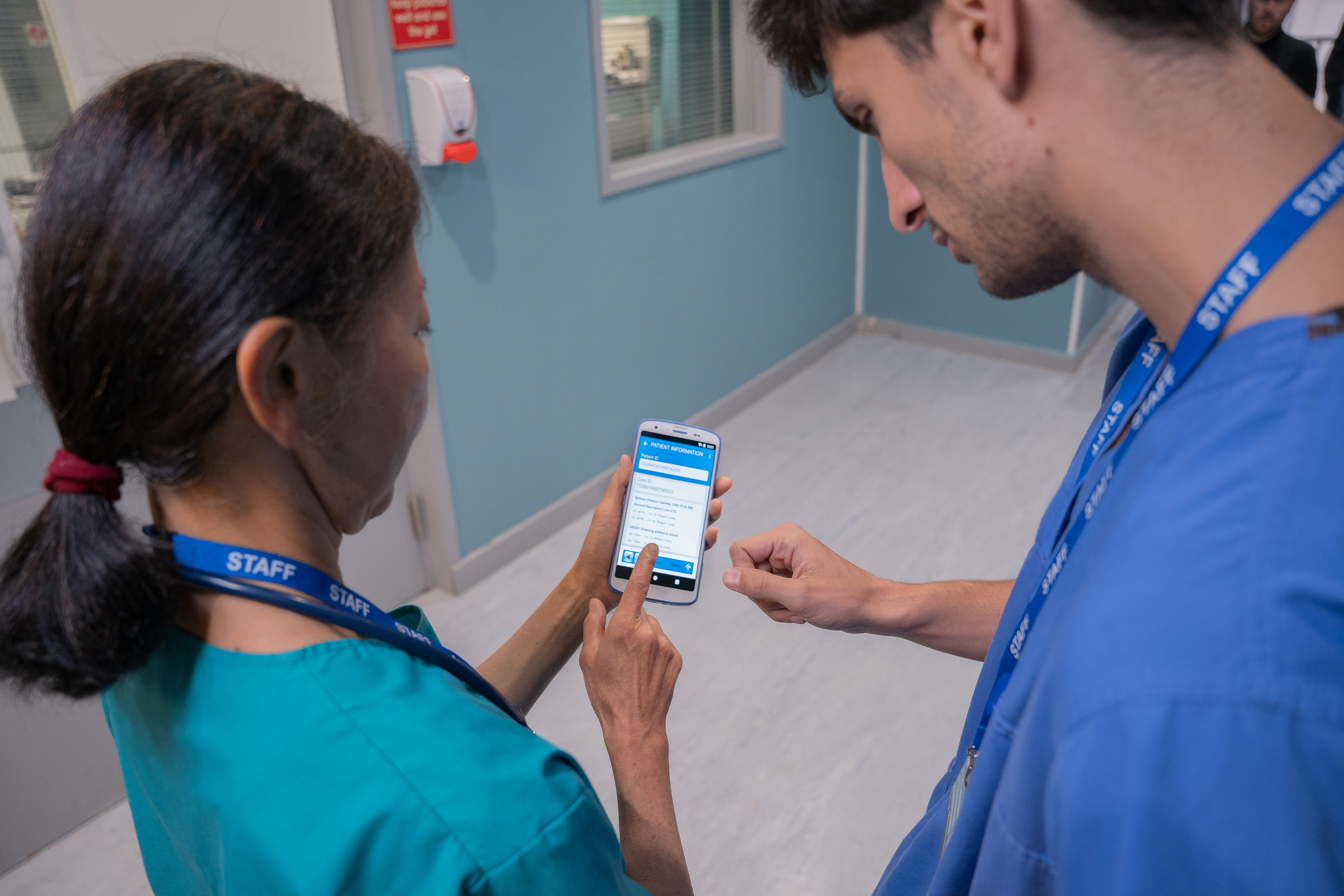
This is Why Tablets, RFID, and Temperature Sensing Technologies are Sparking More Interest from Firefighters, EMTs
Accountability for people, equipment and supplies has never been more mission critical, and gauging the temperature of a situation shouldn’t be a guessing game.
Editor's Note: This post first published in April 2021. Jenny updated it in December 2024.
###
Did you know that public safety agencies were among the earliest adopters of rugged tablet technology over 25 years ago? It’s true. Xplore Technologies, which was acquired by Zebra in 2018, directly involved firefighters, emergency medical technicians (EMT) and other first responders in its design, development and field testing efforts to ensure the (then pen-based) mobile computing platforms would provide the real-time guidance, security, reliability and intuitive experiences users needed to make better, faster decisions.
To this day, we collaborate closely with firefighters, EMTs, fire chiefs, marshals and command staff to ensure they have the tools needed to make the right call on every call. Every time we engineer a new rugged tablet platform – or even a new hardware or software feature – we take into account the very specific human factors, data capture, distribution, collaboration and compliance needs of each individual and department. We also consider the role that technology must play in supporting increased service capacity, even as labor and budget levels remains stagnant. This helps to ensure that first responders such as those at the Nicholasville Fire Department have functional technology tools they can rely on for a very long time for a large number of applications, including navigation, HAZMAT management, task management, incident reporting and even backup communications (if radios were to ever go down).
However, tablets are simply one of the many technology tools that have been adapted to the needs of these frontline heroes.
Firefighters and EMTs are Starting to Mobilize More Units with Advanced Technology Tools
As demand for fire and emergency medical services support has surged to record levels in recent years, so has demand for technologies that improve responsiveness, situational awareness, asset management and multi-agency coordination.
That’s why we’re now seeing first responders emerge as some of the most ardent adopters of RFID technology and other “advanced” technologies that make the fundamental aspects of their job – asset management, dispatch and scheduling, even on-scene accountability – easier to track.
With the volume of large-scale incidents such as wildfires multiplying each year alongside a growing number of major weather events, chemical spills, vehicle accidents, and active shooter situations, it is imperative that we work together to:
- Minimize burnout among first responders considering how many calls they’re answering and how much longer their shifts are becoming.
- Maintain accountability for first responders for the sake of their health and safety and to paint a realistic picture of incident response capacity.
- Facilitate more remote command capabilities given how many different scenes one agency may have to work at once.
- Get all first responders – and even second responders – on the same page from a communications and coordination perspective, especially given the growing number of multi-agency responses and fast handoffs required for continued patient care.
- Make it easier to maintain and replenish equipment before, during, and after shifts.
- Automate as much of the administrative work as possible, including scheduling, inventory counts, reporting, and more.
Of course, I know many agencies don’t have the resources to rip and replace all legacy systems at once or introduce technology in areas traditionally supported via manual processes – at least not as fast as everyone would like. And I realize you may be one of the many fire chiefs who must be very strategic with your budget spend right now. However, we’ve been working with many agency leaders to prioritize technology solutions like mobile technologies, temperature sensing technologies and RFID systems that can have a high impact on day one, and with excellent results.
There are Plenty of Unknowns in the Field. This Can Help Eliminate Some of Them.
I know I’ve mentioned them twice now, but the Nicholasville Fire Department realized that a single simple change such as giving first responders purpose-built rugged tablets loaded with the right software can make a huge difference on an entire operation. As soon as its crew arrives on the scene of a medical emergency, it can immediately start collecting information on the tablet to pass along to additional responders. The built-in camera allows them to take and share pictures with partner agencies for their incident response planning, which helps speed up care once on the scene and later when patients are transferred to a hospital for further treatment. The tablet can also be used to scan license plates and drivers’ licenses at the scene of automobile accidents to ensure fast, accurate reporting to law enforcement, insurance and other interested parties. (This helps mitigate risk of one wrong manual letter or number input on an incident report having costly consequences for both the agency and victim.) Even fire marshals have boasted about how much a camera-equipped tablet can streamline inspection processes and help minimize disputes later.
Another reason many fire departments are updating their tablets and handheld mobile computers is they’re realizing without the right built-in wireless communications technologies – 4G/5G, Wi-Fi and push-to-talk (PTT) – a device really isn’t that valuable to them. Not all mobile devices are certified with emergency response networks or multi-SIM compatible – two things that are critical when covering both urban and remote areas or providing support in other jurisdictions for large-scale incidents. So, many agencies are switching to devices that are truly mobile and trusted to stay connected to a wireless signal so frontline responders can access mission-critical, back-office systems for response planning, incident reporting and real-time decision-making no matter how far away from the station they may be.
Temperature-sensing technology is also proving vital to decision-making in the field, specifically as it relates to the viability of medications, blood products and other regulated perishables.
MedStar Mobile Healthcare delivers lifesaving emergency medical attention to nearly one million people in Fort Worth, Texas, and surrounding communities. As part of its Commission on Accreditation of Ambulance Services (CAAS) certification, MedStar must ensure the medications and medical devices it keeps in its ambulances are stored and maintained at a certain temperature. The company’s leaders also wanted EMTs to be confident that the temperature-sensitive items hadn’t been heat compromised prior to administration. The last thing anyone wants to do is inadvertently make a situation worse for a patient.
So, MedStar leaders contacted us a few years ago to learn more about the ways in which temperature indicators could be used on individual items to give crews visual indicators when a temperature excursion happened. Though effective in flagging potential issues, the MedStar team quickly realized that it would be better served by a sensor that could go beyond relative temperature exposure confirmation and also provide temperature data history. MedStar leadership decided to switch to a Bluetooth-enabled, cloud-based data logger that would automatically record and report ambulance temperatures at certain intervals for easy access by staff both inside the ambulance and back at the station. The MedStar team was able to improve its medication handling protocol and reduce the quantity of medication required to be destroyed because of suspected temperature excursions. The crew’s confidence in the viability of on-board inventory also grew after this change.
The Clemson Fire and EMS team was in a similar situation when its leaders decided to install Bluetooth-powered temperature monitors in ambulances to ensure temperature-controlled medications were being properly stored. The insights garnered from the technology solution enabled department heads to make strategic adjustments to the ambulance’s cold storage environment to reduce waste. For example, the team learned that its mini refrigerators need to be powered by an inverter in order to maintain stable temperatures and properly preserve valuable medications.
With the Right Technology, It’s Easy to Track and Trace Everyone and Everything
If you’re looking at ways to improve accountability, you’re not alone. We’ve worked with many first responder teams that have had to invest in solutions to improve inventory management amidst prolonged shortages, increased HAZMAT exposures, and rising utilization rates.
Of course, budget constraints have required agencies such as Pasco County Fire Rescue and the Bonita Springs Fire Control and Rescue District to be very intentional and diligent with operational spend when trying to improve accountability for everything from equipment to people. But I like the approach they took.
Both Florida-based agencies approached one of Zebra’s Independent Software Vendor (ISV) partners in recent years with the same goal: find a way to track inventory and assets in real time while ensuring first responders have the required equipment and medications for emergencies.
Comprised of 29 stations with 675 members, Pasco County Fire Rescue has one of the top 10 busiest stations in the country and covers 850 square miles of urban, residential, industrial and agricultural areas. In 2019, its team started looking for a better way to get a handle on asset management because expenses for supplies were continually increasing – and budget allocations weren’t keeping up. Plus, the agency’s manual system of logs and pick tickets allowed blind spots in the chain of custody for things such as narcotics, and it was up to first responders to come in and sign out the medications and other supplies they needed for their trucks.
So, a trusted partner recommended that agency leaders consider an RFID solution for automated tracking and 24/7 management of warehouse inventory. Since deploying the technology, each stationhouse team has been able to boost its control over stock levels, which has saved over $3,500 monthly. They have also been able to more efficiently allocate equipment, supplies and medicines to first responders, which has helped to improve accountability and safety. (You can get the full scoop in this story.)
Similarly, leaders of the Bonita Springs Fire Control and Rescue District just down the coast were able to cut costs for disposables and medications by 50% and cut time spent on inventorying assets by over 95% after introducing an RFID-based inventory management system. The District team, which operates seven firehouses, has to keep thousands of different assets on hand to effectively respond to more than 7,000 calls each year in its district related to fires, accidents and other life-threatening medical emergencies. For a long time, it struggled to keep track of these resources, which are geographically dispersed across stations, master supply rooms, and Advanced Life Support (ALS) apparatuses such as fire engines, rescue units and boats. The manual process was time consuming and fallible. So, it started adding RFID tags to assets and giving asset managers and crews handheld mobile computers with RFID sleds that can automatically identify the location and confirm the status of any RFID tagged item in range. The team can literally read hundreds of items within seconds, which helps asset managers know exactly what’s on hand at each location so it can balance (and reorder) inventory accordingly. This RFID solution has also reduced the risk of sending first responders into the field with expired medications, which helps to protect the health and safety of patients they’re called to stabilize. (You can read more about how the District team’s using RFID and how it achieved an 100% return on investment in the first year here.)
Of course, supplies and equipment aren’t the only “assets” that you probably want to be able to track better.
That’s one of the reasons why the team at Battalion 3 (BATT3) developed its Fire Roster software for use with Zebra rugged tablets. The other? Passport tags simply weren’t cutting it anymore when it came to keeping tabs on who was on scene and how long they had been in the fight.
As fire chief and BATT3 co-founder John Morrison once said, “Even the most organized incident commanders find it time consuming and tedious to cross-reference and manage these Passport tags alongside their dry erase board rosters…This old way of handling firefighter accountability and tracking is potentially dangerous.”
That is why members of his agency, the Coeur d’Alene Fire Department, along with leaders of two other fire and rescue agencies in his county – Northern Lakes Fire Protection District and Kootenai County Fire and Rescue – were eager to find a better solution. It’s been nearly 15 years since the BATT3 team began developing the first all-digital command, control and accountability solution for emergency response and, today, it’s used by agencies all across the U.S. to minimize the risk of firefighter mayday, including Northern Lakes.
Every time a firefighter is dispatched from the command center, a clock is turned on in the BATT3 app and the indicator next to the person’s name turns green on the rugged tablet screen – similar to how a unit/engine tracker works. After 10 minutes, each crew member’s indicator will turn yellow and can automatically trigger a roll call. The command center can then call backup personnel as deemed necessary using an integrated CAD program, which eliminates the previously time-consuming manual call-back method and enables chiefs to maintain a frequent, automated role call cadence for accountability. They always know the location of each firefighter and can identify immediately if someone is in distress.
The crew-tracking solution also records every action taken in the BATT3 app to automatically create a digital incident log. These “save” triggered screenshots of the crew member’s name, unit number, and progress against the timer help improve the quality of incident audits. They also give fire chiefs the insights needed to improve training and adjust best practices for future calls.
Given the positive response from around the nation – and the world – the BATT3 team started looking at other areas that could be improved by digitization. Incident command was a biggie, mainly because there are so many moving parts. Fire chiefs and battalion commanders repeatedly told them they wanted complete situational awareness and control from one screen – or at least one mobile app. So, they came up with a tool that is now used by agencies across North America.
A Final Thought
Your crew – and all first responders – are inevitably going to be inundated with a constant stream of information that’s difficult to process for split-second decision-making. Yet, they don’t have time to stop and think about the best next step to take or whether a proposed plan of action might compromise someone’s safety. They need guidance from a trusted source. That’s why it’s so important that anyone calling the shots has real-time access to incident-related data collected by all parties – including other responding agencies and dispatch – and collated by an automated analytics system that can help inform human decision-making based on fact, not speculation.
Crews also need to trust that their safety is being prioritized at all times. Anything that wavers their confidence in their equipment or each other could shift their focus away from what matters most: predicting others’ needs and preventing further problems from arising.
If you’re in a position where you and your crews must now do more with less, invest in technologies that can quickly be integrated in your operations to help relieve some of the guesswork and busy work as well as the mistakes and oversights that lead to more work. With crew accountability every chief’s priority, know that technology that helps maintain 100% accountability is both available and proven. RFID isn’t only for retailers. It can tremendously help you in your warehouses, in ambulances and fire trucks, and even back at the station. And mobile technology needs to help automate as much as possible for the sake of efficiency. It’s not necessarily going to take core responsibilities off your crew, but it is going to make those responsibilities feel less burdensome so they can get some true R&R between calls or go home sooner at the end of each shift.
I know it’s a challenge to balance your budget in today’s climate, but I don’t foresee that changing anytime soon. So, the best advice I can give is to find a technology partner that you trust to help you strategically implement solutions that will solve problems, not create more of them.
###
Editor’s Note:
You can learn more about the Zebra solutions used by firefighters and EMTs today on this resource page. You may also find these recent discussions helpful:
Webinar: Tech-driven tactics: Innovating incident command for safer firefighting
Hear about the latest technology that is keeping firefighters safe and organized and gain insights into innovative safety measures enabled by technology, such as wearable sensors and predictive modeling. You'll also get a sneak peek at a new technology for enhanced firefighter accountability.
Ask the Expert: How Can I Better Respond to Emergency Medical Technicians’ Calls for Help?
When an ambulance is dispatched to a call, the assumption is that it will be fully stocked with the right equipment and medicines for EMTs to stabilize patients or perform life-saving measures in the field. But with the increased number of calls for service, it’s becoming more difficult for EMTs to maintain proper stock in their ambulances – and that has patient care implications. Why is such a fundamental task so hard to manage? That’s one of the questions we asked two public safety experts. The other question? Is there anything that can be done to reduce the wait times for ambulance services where the calls for service are exceeding EMTs’ capacity? These experts have some thoughts.
Three former public safety professionals explain why they are now working with law enforcement, fire and rescue agencies to get certain technologies into the field. They want today’s first responders to have the full support and situational awareness they need, as they explain in this podcast discussion.






